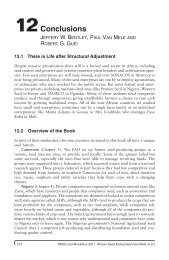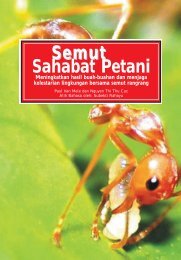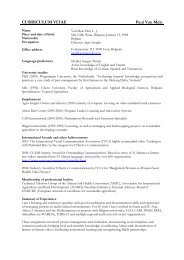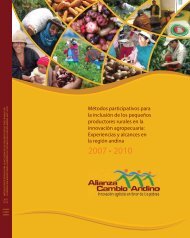Video-mediated farmer-to-farmer learning for sustainable agriculture
Video-mediated farmer-to-farmer learning for sustainable agriculture
Video-mediated farmer-to-farmer learning for sustainable agriculture
Create successful ePaper yourself
Turn your PDF publications into a flip-book with our unique Google optimized e-Paper software.
apple trees, and some other videos from YouTube related <strong>to</strong> <strong>agriculture</strong>. All these videos<br />
were made by agriculturists around the world.”<br />
Ahmed Fida Habibyar, Knowledge <strong>for</strong> Development Organization, Afghanistan<br />
Various projects are experimenting with video on mobile phones. The University of Illinois is<br />
experimenting with a system whereby an expressed demand <strong>to</strong> solve a problem in a developing<br />
country is translated by people at the university in<strong>to</strong> an animated car<strong>to</strong>on. These are hosted on<br />
their website (http://susdeviki.illinois.edu) and downloadable <strong>for</strong> mobile phones.<br />
Purdue University has a project funded by the Bill and Melinda Gates Foundation in ten African<br />
countries <strong>to</strong> create impact with an improved cowpea s<strong>to</strong>rage technology. The project developed<br />
video sketches <strong>for</strong> mobile phone use among other extension materials. Their video clips are about<br />
seven minutes long (http://www.ag.purdue.edu/ipia/pics/Pages/Home.aspx).<br />
Although video <strong>for</strong> mobile applications is modern and sexy, and hence attracts quite a bit of donor<br />
and media attention, still:<br />
o very few <strong>farmer</strong>s in developing countries have mobile phones with video applications;<br />
o the need <strong>for</strong> content remains as valid as <strong>for</strong> other video viewing methods;<br />
o the type of in<strong>for</strong>mation that can be presented is limited due <strong>to</strong> limitations in memory and<br />
screen display; and most importantly<br />
o mobile phone viewing of video is individualistic, benefits mainly better-off <strong>farmer</strong>s, and has<br />
reduced scope <strong>for</strong> group interactions.<br />
3.4.8 <strong>Video</strong> viewing clubs<br />
This is an analogy <strong>to</strong> earlier radio listener clubs. The method has been tested on a small scale in<br />
Ghana and Ivory Coast by IITA (David & Asamoah, 2011). In 2006, pilot video viewing clubs trained a<br />
<strong>to</strong>tal of 180 women <strong>farmer</strong>s on cocoa ICPM through five videos on the following <strong>to</strong>pics: pruning<br />
cocoa trees, controlling black pod disease through cultural practices and using fungicides,<br />
harvesting, pod breaking fermentation and drying.<br />
The quality of the videos, as measured by <strong>farmer</strong>s’ satisfaction, no doubt had a positive effect on<br />
the <strong>learning</strong> process. Farmers were clearly encouraged by the testimonies given by <strong>farmer</strong>s in the<br />
videos and by seeing other <strong>farmer</strong>s carrying out the practices on their farms. Most participants<br />
highly appreciated the clarity of the technical messages and language used which suggests a<br />
positive outcome of involving <strong>farmer</strong>s in the video development process (David & Asamoah, 2011).<br />
Each club consisted of about 20 <strong>farmer</strong>s led by a trained female facilita<strong>to</strong>r, also a cocoa <strong>farmer</strong> from<br />
that community. All facilita<strong>to</strong>rs had at least 10 years of <strong>for</strong>mal education. The project provided a<br />
video deck, a television, a small genera<strong>to</strong>r and fuel, but did not supply <strong>to</strong>ols or pesticides during the<br />
pilot phase. Clubs met either weekly or biweekly in a variety of locations (homes, cocoa buying<br />
sheds and schools) <strong>to</strong> watch the videos and carried out field exercises in one participant’s field.<br />
Digital Green in India has opted <strong>for</strong> a more flexible model, whereby not the members of the clubs<br />
are fixed, but the village video modera<strong>to</strong>r is. He or she receives a monthly payment <strong>to</strong> organize<br />
small group video viewings in their village four days a week. The location and people attending<br />
varies according <strong>to</strong> the subject of the video and demand of the people.<br />
<strong>Video</strong> <strong>for</strong> <strong>farmer</strong>s Agro-Insight, Oc<strong>to</strong>ber 2011 page 16







